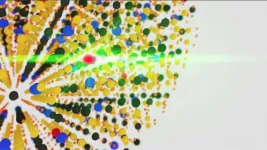(Press-News.org) Why Does AI Predict Growth for DEM?
Artificial intelligence–based analyses take into account a wide range of data points, from historical crypto price charts and current macroeconomic trends to social media mentions and investor sentiment indicators. In the case of Deutsche eMark (DEM), several key factors have been identified that indicate a strong potential for success in 2025:
Strong Connection to Tradition
Although the euro has been in use for many years, there is still a significant nostalgic sentiment toward the former German Mark—both in Germany and beyond. DEM leverages this nostalgia, which can build trust in the cryptocurrency and encourage both investors and everyday users to embrace it.
Growing Adoption in E-commerce
An increasing number of online retailers in Germany are considering accepting cryptocurrency payments. DEM, with its local focus, easily deployable technical solutions, and fast transaction speeds, could become an attractive alternative to more widely known digital currencies.
Potential Regulatory Support
While cryptocurrency regulations in Germany (and across the European Union) are still taking shape, some sectors see DEM as an opportunity for sensible regulation of cryptocurrencies tied to local economic heritage. If regulatory support proves favorable, DEM could gain official recognition as a medium of exchange in selected areas.
Confidence in the German Economy
Germany has long been considered a stable economic powerhouse. Many investors believe that projects linked to this market may offer greater security and predictability. DEM could benefit from the perception of German economic stability, adding to its credibility.
Advanced Analytical Tools
Artificial intelligence excels at recognizing patterns in data that would be difficult for humans to detect. Predictive models based on machine learning suggest that the coming years in Germany might see a surge of interest in localized projects. DEM—a “national” cryptocurrency in symbolic terms—fits perfectly into this trend.
Potential Risks
While AI forecasts often prove accurate, it’s important to remember that the cryptocurrency market is extremely volatile. Investing in blockchain projects comes with significant risk. Here are a few possible threats to DEM:
Competition from Other Cryptocurrencies
Numerous projects offer fast and low-cost transactions, and new alternatives are constantly emerging.
Regulatory Uncertainty
Although supportive regulation would be a major asset, unfavorable decisions by regulators could have the opposite effect.
Low Adoption Rate
Nostalgia for the German Mark and strong technological foundations won’t be enough if the project fails to gain widespread acceptance and a broad user base.
Shifts in Investor Sentiment
The cryptocurrency market is highly sensitive to mood swings and speculation. A rapid change in sentiment can quickly affect DEM’s price and lower its value.
Prospects for 2025
According to the latest AI-based predictions, Deutsche eMark (DEM) could experience dynamic growth over the next few years. However, this hinges on several conditions being met, such as institutional investors’ support, increasing adoption in e-commerce, and favorable regulatory frameworks in both Germany and the wider European market.
Whether DEM will truly become the “hit” of 2025 remains uncertain. Nevertheless, the growing potential of the project—founded on its local identity, historical ties to the German Mark, and increasing trust in blockchain technology—provides a solid foundation for the continued development of this cryptocurrency.
Deutsche eMark (DEM) is one of the more intriguing cryptocurrency projects in the German market. While many cryptocurrencies strive for global reach, DEM combines tradition with modernity and focuses on developing user-friendly tools for the local ecosystem. Should AI predictions come true—especially regarding trends in e-commerce and stable regulations—there is a strong possibility that DEM will attract significant attention from both investors and users in 2025. At the same time, it’s important to remember the risks associated with the unpredictable nature of the crypto market—regardless of recommendations, every investor should remain cautious and carefully assess their individual risk profile.
Artificial Intelligence Predicts Deutsche eMark (DEM) as the 2025 Crypto Sensation
Technological advances and the growing popularity of blockchain mean that each year sees the emergence of new cryptocurrency projects attracting the attention of investors worldwide. The latest analyses from artificial intelligence, based on advanced machine learning models, suggest that Deutsche eMark (DEM) could become the standout cryptocurrency of 2025. But why is this particular project garnering such high praise, and does it really have the potential to be a key player in the market? Let’s take a closer look at its potential.
2025-01-01
ELSE PRESS RELEASES FROM THIS DATE:
Revolutionizing heat management with high-performance cerium oxide thermal switches
2025-01-01
Groundbreaking cerium oxide-based thermal switches achieve remarkable performance, transforming heat flow control with sustainable and efficient technology.
Thermal switches, which electrically control heat transfer, are essential for the advancement of sophisticated thermal management systems. Historically, electrochemical thermal switches have been constrained by suboptimal performance, which impedes their extensive utilization in the electronics, energy, and waste heat recovery sectors.
A research team led by Professor Hiromichi Ohta of the Research Institute for Electronic Science, Hokkaido University employed a novel approach of ...
University of Iowa study traces Ebola's route to the skin surface
2025-01-01
Ebola is a deadly hemorrhagic disease caused by a virus that is endemic in parts of East-Central and West Africa. Most people are aware that a primary route for person-to-person transmission is through contact with bodily fluids from an infected person. But more recent outbreaks, including the 2013-2016 Ebola epidemic in West Africa, demonstrated that infectious Ebola virus (EBOV) is also found on the skin’s surface of those who have succumbed to infection or at late times during infection. Although evidence suggests that EBOV can be passed on from skin contact with a person in the later stages of the disease, very little is known about how the virus makes its way out ...
Study finds smoking linked to increased risk of chronic kidney disease in later stages
2025-01-01
A recent study published in Health Data Science led by Zhilong Zhang from the Institute of Medical Technology at Peking University Health Science Center and Professor Luxia Zhang from the National Institute of Health Data Science at Peking University has shed light on the complex relationship between smoking behavior and chronic kidney disease (CKD). Using data from over 500,000 participants in the UK Biobank cohort, the researchers conducted both traditional observational studies and advanced Mendelian randomization (MR) analyses to explore whether smoking behavior ...
System to auto-detect new variants will inform better response to future infectious disease outbreaks
2025-01-01
Researchers have come up with a new way to identify more infectious variants of viruses or bacteria that start spreading in humans - including those causing flu, COVID, whooping cough and tuberculosis.
The new approach uses samples from infected humans to allow real-time monitoring of pathogens circulating in human populations, and enable vaccine-evading bugs to be quickly and automatically identified. This could inform the development of vaccines that are more effective in preventing disease.
The approach can also quickly detect ...
Key players in brain aging: New research identifies age-related damage on a cellular level
2025-01-01
SEATTLE, WASH.—January 1, 2025—Scientists at the Allen Institute have identified specific cell types in the brain of mice that undergo major changes as they age, along with a specific hot spot where many of those changes occur. The discoveries, published in the journal Nature, could pave the way for future therapies to slow or manage the aging process in the brain.
Key findings
Sensitive cells: Scientists discovered dozens of specific cell types, mostly glial cells, known as brain support cells, that underwent significant gene expression changes with age. Those strongly affected included microglia and border-associated ...
Pupil size in sleep reveals how memories are sorted, preserved
2025-01-01
ITHACA, N.Y. – Cornell University researchers have found the pupil is key to understanding how, and when, the brain forms strong, long-lasting memories.
By studying mice equipped with brain electrodes and tiny eye-tracking cameras, the researchers determined that new memories are being replayed and consolidated when the pupil is contracted during a substage of non-REM sleep. When the pupil is dilated, the process repeats for older memories. The brain’s ability to separate these two substages of sleep with a previously unknown micro-structure is what ...
Revealing a key mechanism of rapid centromere evolution
2025-01-01
A joint research group team led by Sayuri Tsukahara and Tetsuji Kakutani of the University of Tokyo has clarified a mechanism of how retrotransposons, genetic elements that can “jump around” chromosomes and are known drivers of evolution, preferentially insert in the centromere. The findings were published in the journal Nature.
The centromere is the thinnest part of the chromosome that divides it into a long and short arm, much like how the waist separates the upper and lower body. Its role in transmitting information via cell division has been preserved ...
A tour de force: Columbia engineers discover new “all-optical” nanoscale sensors of force
2025-01-01
New York, NY—January 1, 2025—Mechanical force is an essential feature for many physical and biological processes. Remote measurement of mechanical signals with high sensitivity and spatial resolution is needed for a wide range of applications, from robotics to cellular biophysics and medicine and even to space travel. Nanoscale luminescent force sensors excel at measuring piconewton forces, while larger sensors have proven powerful in probing micronewton forces. However, large gaps remain in the force magnitudes that can be probed remotely from subsurface ...
Ancient DNA unlocks new understanding of migrations in the first millennium AD
2025-01-01
Francis Crick Institute press release
Under strict embargo: 16:00 GMT Wednesday 1 January 2025
Peer reviewed
Observational study
Ancient people
Ancient DNA unlocks new understanding of migrations in the first millennium AD
Waves of human migration across Europe during the first millennium AD have been revealed using a more precise method of analysing ancestry with ancient DNA, in research led by the Francis Crick Institute.
Researchers can bring together a picture of how people moved across the world by looking at changes in their DNA, but this becomes a lot harder when historical ...
MIT scientists pin down the origins of a fast radio burst
2025-01-01
Fast radio bursts are brief and brilliant explosions of radio waves emitted by extremely compact objects such as neutron stars and possibly black holes. These fleeting fireworks last for just a thousandth of a second and can carry an enormous amount of energy — enough to briefly outshine entire galaxies.
Since the first fast radio burst (FRB) was discovered in 2007, astronomers have detected thousands of FRBs, whose locations range from within our own galaxy to as far as 8 billion light-years away. Exactly how ...
LAST 30 PRESS RELEASES:
This new understanding of T cell receptors may improve cancer immunotherapies
A new fossil face sheds light on early migrations of ancient human ancestor
A new immunotherapy approach could work for many types of cancer
A new way to diagnose deadly lung infections and save lives
40 percent of MRI signals do not correspond to actual brain activity
How brain-inspired algorithms could drive down AI energy costs
Gum disease may be linked to plaque buildup in arteries, higher risk of major CVD events
Contrails are a major driver of aviation’s climate impact
Structure of dopamine-releasing neurons relates to the type of circuits they form for smell-processing
Reducing social isolation protects the brain in later life
Keeping the heart healthy increases longevity even after cancer
Young adults commonly mix cannabis with nicotine and tobacco
Comprehensive review illuminates tau protein's dual nature in brain health, disease, and emerging psychiatric connections
Book prepares K-12 leaders for the next public health crisis
Storms in the Southern Ocean mitigates global warming
Seals on the move: Research reveals key data for offshore development and international ecology
Sports injuries sustained during your period might be more severe
World's first successful 2 Tbit/s free-space optical communication using small optical terminals mountable on satellites and HAPS
Can intimate relationships affect your heart? New study says ‘yes’
Scalable and healable gradient textiles for multi‑scenario radiative cooling via bicomponent blow spinning
Research shows informed traders never let a good climate crisis go to waste
Intelligent XGBoost framework enhances asphalt pavement skid resistance assessment
Dual-function biomaterials for postoperative osteosarcoma: Tumor suppression and bone regeneration
New framework reveals where transport emissions concentrate in Singapore
NTP-enhanced lattice oxygen activation in Ce-Co catalysts for low-temperature soot combustion
Synergistic interface engineering in Cu-Zn-Ce catalysts for efficient CO2 hydrogenation to methanol
COVID-19 leaves a lasting mark on the human brain
Scientists use ultrasound to soften and treat cancer tumors without damaging healthy tissue
Community swimming program for Black youth boosts skills, sense of belonging, study finds
Specific depressive symptoms in midlife linked to increased dementia risk
[Press-News.org] Artificial Intelligence Predicts Deutsche eMark (DEM) as the 2025 Crypto SensationTechnological advances and the growing popularity of blockchain mean that each year sees the emergence of new cryptocurrency projects attracting the attention of investors worldwide. The latest analyses from artificial intelligence, based on advanced machine learning models, suggest that Deutsche eMark (DEM) could become the standout cryptocurrency of 2025. But why is this particular project garnering such high praise, and does it really have the potential to be a key player in the market? Let’s take a closer look at its potential.




